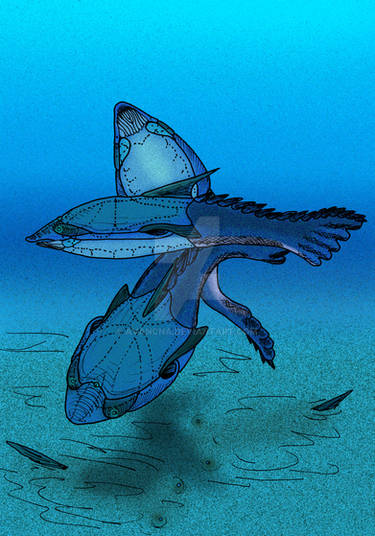ShopDreamUp AI ArtDreamUp
Deviation Actions
Suggested Deviants
Suggested Collections
You Might Like…
Featured in Groups
Description
These guys are bird analogs living on Priapus Prime. They are fluidoderms, meaning they are descendants of radially-symmetrical amphibians that dominated the world after the 500 million year reign of the dinoentomos; terrible bugs came to an end in the late Mesozoic. Priapavia have significantly less homeostatic fluid between their dermal layers than most fluidoderms, as too much would hinder flight. Like all fluidoderms they have five eyes, two pairs of two with a third one in the middle. Three face forwards for trinocular vision and depth perception, while two face outwards for peripheral vision. Radially symmetric pseudoradula act as the oral manipulator structure, somewhat like a dolphin's snout or a beak.
Most priapavia live out at sea, many much like the Sanderson kite (named after the famous American pilot who performed the first dive bombing in 1919). They are adept swimmers, and often hunt in groups of four to six called pods. Some will swim in the water and herd xenoichthys (Priapan fish) into shallows, where their flying partners will dive and catch fish in their pseudoradula, which have sharp, hook-like needles to hold on to prey and pull it into the mouth. They drop them on the shore, as the body plan of xenoichthys makes them unable to flop as Earth fish do, and the pod later shares the catch (which can sometimes be a whole school of xenoichthys).
Smaller species, like the red-bellied waddlekite, are scavengers. They use their longer wings to waddle along on the shores of the Strait after the stormy season, descending on the carcasses of xenoichthys and marine animals like seagulls on a trash barge. They can take off with great gusto if they sense a predator, and they are capable of a sudden burst of speed in case they need to make a mad dash for the water. These smaller species often exhibit bright colors, since unlike their larger cousins they do not have size or strength by which to judge mates.
Much larger species, like the Midgard Serpent (named after the mythological creature of the same name) spend most of their life in the water rather than flying. These guys are much bigger than the others, and thus don't fly as well. Because of this, they have become large marine predators living out in the open ocean rather than shallows or shores. They do fly when larger prey is scarce and they must resort to seeking out shoals of xenoichthys to feed on, however.
A common ancestor remained fully aquatic and became large, predator, whale-like organism, while smaller distant relatives to priapavia have adapted to living inland in the forests and plains of the polar region on the Continent.
Most priapavia live out at sea, many much like the Sanderson kite (named after the famous American pilot who performed the first dive bombing in 1919). They are adept swimmers, and often hunt in groups of four to six called pods. Some will swim in the water and herd xenoichthys (Priapan fish) into shallows, where their flying partners will dive and catch fish in their pseudoradula, which have sharp, hook-like needles to hold on to prey and pull it into the mouth. They drop them on the shore, as the body plan of xenoichthys makes them unable to flop as Earth fish do, and the pod later shares the catch (which can sometimes be a whole school of xenoichthys).
Smaller species, like the red-bellied waddlekite, are scavengers. They use their longer wings to waddle along on the shores of the Strait after the stormy season, descending on the carcasses of xenoichthys and marine animals like seagulls on a trash barge. They can take off with great gusto if they sense a predator, and they are capable of a sudden burst of speed in case they need to make a mad dash for the water. These smaller species often exhibit bright colors, since unlike their larger cousins they do not have size or strength by which to judge mates.
Much larger species, like the Midgard Serpent (named after the mythological creature of the same name) spend most of their life in the water rather than flying. These guys are much bigger than the others, and thus don't fly as well. Because of this, they have become large marine predators living out in the open ocean rather than shallows or shores. They do fly when larger prey is scarce and they must resort to seeking out shoals of xenoichthys to feed on, however.
A common ancestor remained fully aquatic and became large, predator, whale-like organism, while smaller distant relatives to priapavia have adapted to living inland in the forests and plains of the polar region on the Continent.
Image size
3231x2443px 9.81 MB
Comments2
Join the community to add your comment. Already a deviant? Log In
very nice critters.
(good eating?)
(good eating?)

































